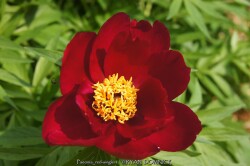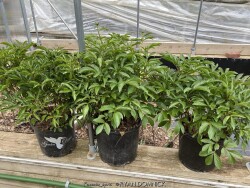


Plant Min Zone: 2a
Plant Max Zone: 7b
Sunlight: Full Sun, Part Sun
Water / Rainfall: Average
Soil Quality: Average, Rich
Bloom Season: Spring, Early Summer
Flower Color: Red
Berry / Fruit Color: None
Spring Foliage Color: Green
Summer Foliage Color: Green
Fall Foliage Color: Green, Reddish Green
Evergreen Foliage: No
Winter Interest: No
Scented Flowers: Yes
Drought Tolerance: Medium, High
Wet-Feet Tolerance: Low, Medium
Humidity Tolerance: Medium, High
Wind Tolerance: Medium
Poor Soil Tolerance: Clay Soils, Rocky Soils
Height: 1.5' - 2'
Width: 1.5' - 2'
Growth Rate: Slow, Medium
Service Life: Extremely long: over 20 years
Maintenance Need: Medium
Spreading Potential: Low
Yearly Trimming Tips: Trim Perennial to Ground Around First Fall Freeze: No Winter Interest.
Plant Grouping Size: Small Grouping of 3-5, Medium Grouping of 5-10
Best Side of House: East Exposure, North Exposure
Extreme Planting Locations: Survives Severe Drought, Resistant to Rabbits
Ornamental Features: Emerges Early in Spring, Large Tropical Foliage / Flowers
Special Landscape Uses: Groundcover
Possible Pest Problems: Foliage Disease, Root Rot Disease
Plant Limitations: May Needs Staking, Susceptible to Juglone / Black Walnut, Overused in the Landscape, May be Poisonous
Shippable in 2026: YES
Peonies (Paeonia), along with roses are one of the most universally well-known flowers. The toughness and durability of this plant can be seen in cemeteries or around abandoned houses, surviving decades even 100 years or more without care. Peonies are native to China in cold continental climate areas but also do well in Kansas. Large flowers come in different shades of white, red, and pink. Peonies bloom usually around Memorial Day hence their popularity and cemeteries. Blooming lasts about 2 weeks but can be short-lived if a thunderstorm happens during the last week of blooming when petals are fully open. In zone 6 and south, the foliage is glossy green and attractive throughout the first half of summer. Usually, by late summer, foliage is tattered from drought stress and diseases. This has no ill effect on the health of the plant as it is already set its growth buds for next year. In northern areas (USDA zones 3-5), Peony foliage lasts all summer and turns a brilliant red and orange color in the fall. Due to its need for cold winters, peonies will not grow well further south than zone 8b. Gardeners in south Florida have had success getting peonies to bloom by dumping a bag of ice on the dormant plant every day for 5-6 weeks in winter: sounds like a lot of work huh! Due to its cold tolerance, peonies may be grown in above-ground pots or raised planters year-round. When planting outside, be careful to plant at the correct depth with pink buds slightly below the soil or plants will not bloom. Overall, peonies are a very reliable long-lived plant in Kansas surviving everything. But they do require some maintenance to look their best. Ultra cold-hardy plants from northern climates normally dislike our long hot humid summers; although we are on the Southern edge of this plant's adaptability, it still survives reasonably well here. Look for a cold microclimate planting location such as East or North exposure.